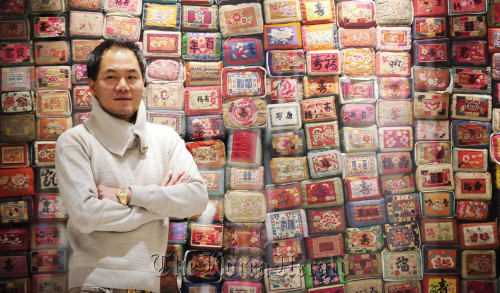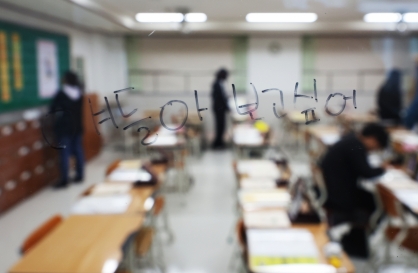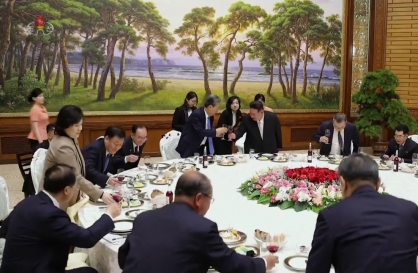The Shilla Seoul hotel has something new at its arcade. But it isn’t western-style haute-couture or designer labels that catch the eye. What grabs your attention are the four big Chinese characters in vermeil red ― Jeon Tong Han Bok ― meaning traditional hanbok boutique.
The shop is run by Kim Young-seok. His bold signature transformation of conventional hanbok is what lures in the visitors.
Unlike exultant designers who have worked industriously for decades, it only took 10 years for Kim to reach the top of his profession.
He is one of the best known traditional hanbok couturiers, tailoring for the nation’s President, the first lady, and top celebrities. But he is also well respected by industry artisans ― something unusual for such a suddenly successful designer.
It is his staunch philosophy of hanbok design that makes him respected by so many. For Kim, the two words “tradition” and “modernity” are not contradictory or mutually exclusive.
He is not afraid of blending his fabric with pastel colors, nor adorning it with European-styled Swarovski jewelry. He pursues constant innovation in hanbok styling, but refrains from violating traditions.
The shop is run by Kim Young-seok. His bold signature transformation of conventional hanbok is what lures in the visitors.
Unlike exultant designers who have worked industriously for decades, it only took 10 years for Kim to reach the top of his profession.
He is one of the best known traditional hanbok couturiers, tailoring for the nation’s President, the first lady, and top celebrities. But he is also well respected by industry artisans ― something unusual for such a suddenly successful designer.
It is his staunch philosophy of hanbok design that makes him respected by so many. For Kim, the two words “tradition” and “modernity” are not contradictory or mutually exclusive.
He is not afraid of blending his fabric with pastel colors, nor adorning it with European-styled Swarovski jewelry. He pursues constant innovation in hanbok styling, but refrains from violating traditions.

“The line should keep the tradition, but the color, I use it freely. I try to avoid the same colors as others, and try to transform and expand my range of colors. That is probably why people buy my collections,” Kim told The Korea Herald as he emphasized the balance between convention and current trends.
British artist Jeremy Dickinson’s work occupies a very important place at his boutique and, besides the frame, Kim’s patchwork wall of traditional Korean pillows somehow resembles his paintings.
Months before, on the same spot, there was a painting by Andy Warhol, but right beside the modern art works, he displays furniture and accessories with the essence of the Joseon Dynasty.
“The real definition of tradition is evolution. Dwelling on and holding fast to a principle is not the right definition. Change is not retrogression.”
Far from a stereotypical hanbok designer, he is tall and slim, tidy without a goatee or beard; he has the image of a model just out of a Ralph-Lauren poster ― and thinks like one too.
“I’m thinking ... how about shortening 10 centimeters off the women’s hanbok skirt? Or a slim-fit styled hanbok?” he said.
“Hanbok should follow the ebb and flow, I should develop a more casually worn hanbok, not so much the ‘modernized hanbok’ of these days that changed only a few things to stay in another category.”
The designer likens hanbok to kimchi.
“Too strong Korean taste in kimchi, for instance, Jeolla province kimchi, it can’t meet the global taste. Some people would prefer Seoul-style kimchi. That’s what a culture is ― coexistence of various cultures. Likewise, hanbok should be altered to match whom wears it. Adhering to tradition is important but being trendy blindly can be actually retrogression, which is dangerous.”
A stubborn adherence to tradition and simultaneous pursuit of change is likely to face what he said is the “danger” of making blunders with respect to the traditional culture. But that is not a big deal for Kim, who learned his needlework for hanbok from a human cultural asset designer. He is following the steps of the late Hur Young, who he said “organized the chaotic (fusion) period of hanbok back into the ‘traditional Korean’ style.
The hanbok designer regards those who abandon the tradition dangerous. “Some people don’t do pyebaek (a traditional ceremony to pay respect to the groom’s family after a wedding), out of a belief that to skip the process is a more modern way of getting married. But that’s a dangerous way of thinking that could destroy a tradition.”
“There are some people who argue that miso (Japanese styled soy bean paste) is better than doenjang (Korean bean paste) just for its mild smell, but that is wrong. A ‘balance’ of views is needed. It means being not in a complete disregard of origin. If you completely deny the tradition, then the future will become obscure.”
Asked about his ultimate goal of life as a hanbok designer, his answer was unexpected, but hinted at this link between past and future:
“My wish is to build a nursing home, and I’m thinking about adding an orphanage to it side by side.”
By Hwang Jurie (jurie777@heraldcorp.com)


















